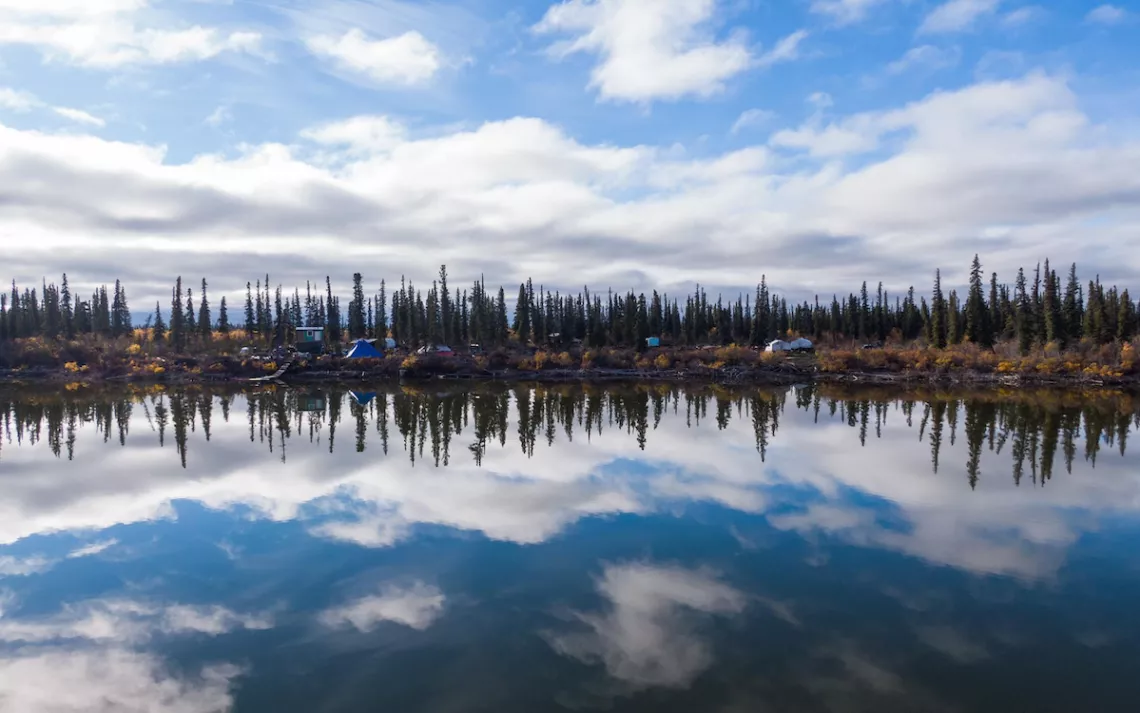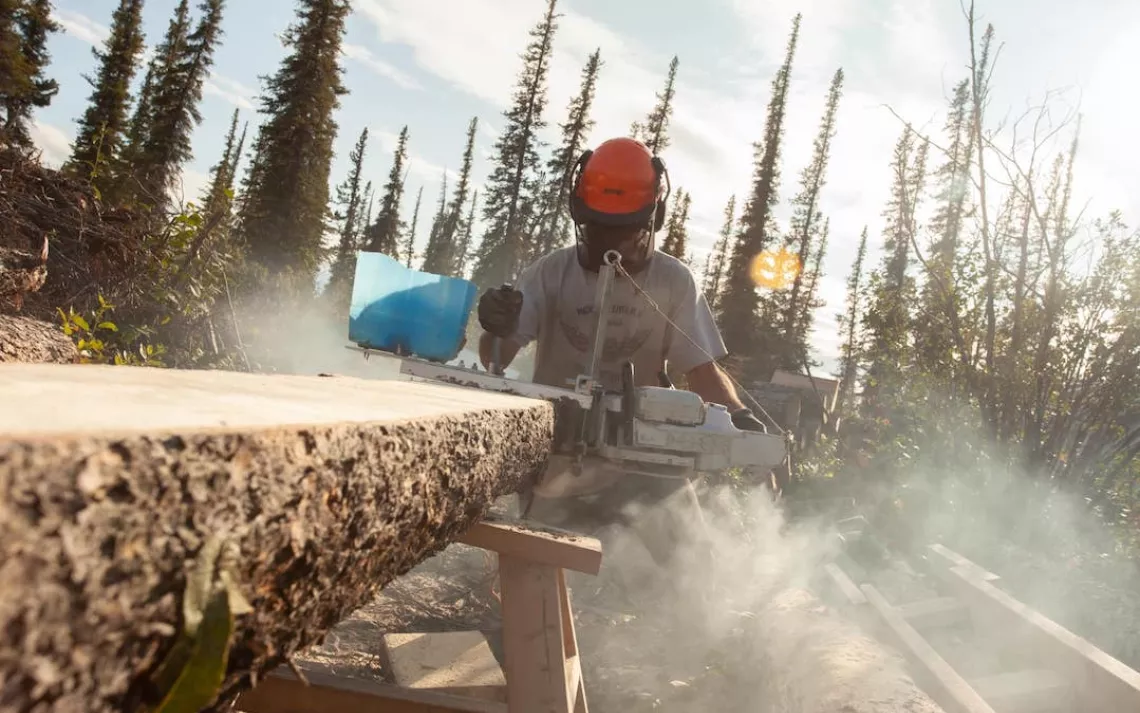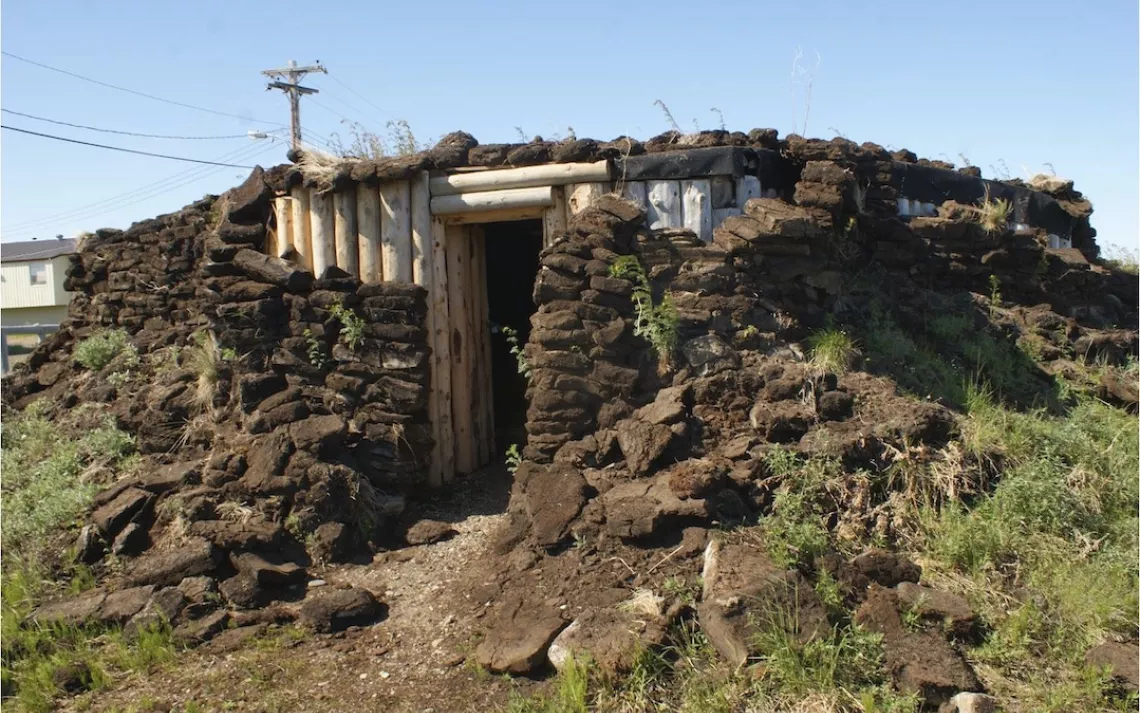An Arctic Village Is Reclaiming Indigenous Architecture
Can traditional techniques protect against an uncertain future?

Photo by Tundra North Tours
The Mackenzie River flows north through Canada’s Northwest Territories, from the boreal forest surrounding Great Slave Lake to the treeless tundra where it empties into the Arctic Ocean. During spring runoff, great spruce logs float north and wash up in piles. Traditionally the Inuvialuit—the Inuit of Canada's western Arctic—would collect this driftwood to build sod houses in their settlements, covering the timber in living grass and soil that insulated against harsh Arctic winters.
It’s been around 50 years since Arctic peoples lived in sod houses. Colonialism and its ensuing intergenerational trauma disrupted traditional lifestyles here, disconnecting communities from such practices. But Inuit technologies are not lost or forgotten: Today, many young Indigenous people of the North are reclaiming their heritage while seeking a more resilient future.
One is Kylik Kisoun Taylor, who had been running Tundra North Tours from the village of Inuvik for more than a decade when the COVID-19 pandemic hit. The Northwest Territories closed to tourists for more than a year, simultaneously destroying Kisoun Taylor’s livelihood and inspiring the 37-year-old Inuvialuit/Gwich’in man to embark on a new way of life. He and his teenage daughter moved to an island 10 miles north of Inuvik and began building an off-grid community where the family could hunt, gather, and live in a simple canvas-covered teepee. Last summer, he added a sod house using materials sourced from the land.
The Okpik Arctic Village, as Kisoun Taylor named the new community, is within his traditional homeland in the overlapping Inuvialuit Settlement Region and the Gwich’in Settlement Region. Housing in Inuvik, which with 3,500 majority-Indigenous residents is the area’s main town, is often poor-quality, scarce, and overcrowded. Food insecurity is a recurring problem. By relying on traditional skills and local materials, Kisoun Taylor hopes that the village can serve as a model for Inuvik and for other Northern communities working to alleviate both issues.
“There’s no reason to have a housing crisis or food insecurity when everything we need is here,” he tells me as we pick blueberries and cloudberries in the bush behind the village, which is open to both tourists and community members. “I wanted to live off the land, and this place has all the elements that I need.”

Photo by Tundra North Tours
Around the circumpolar North, there is a growing realization that substandard housing causes grave problems. Residents in poorly insulated homes spend too much money on heating, while inadequate ventilation leads to mold linked to respiratory illnesses. In Alaska, the Cold Climate Housing Research Center draws on principles from traditional Indigenous architectural techniques to create prototypes that can withstand the elements. Founder Jack Hébert’s vision for the center reflects his experience living in an Iñupiaq sod house in the 1970s. Projects have included partnering with the Tagiugmiullu Nunamiullu Housing Authority and the village of Anaktuvuk Pass to create an energy-efficient, sod-roofed home.
“There’s a reawakening occurring that is incredibly encouraging, and that is the wisdom of traditional ways,” he tells me by phone from Fairbanks. “It’s the 21st century. We’re not going back in time, but we can go back to the values and ways of living that are timeless and bring them into this day so that we can be comfortable and warm.”
Simply importing housing solutions from the south doesn’t work in the North, says Hébert, nor does “not listening to the people that live there and have lived there successfully for so long.” Listening and learning from Indigenous practices “in design and the way we build things is something that is exciting and encouraging,” he says. Using local materials, he adds, means Northern communities can “live in a compatible way with our environment.”
At Okpik Arctic Village, a small sawmill produces lumber with driftwood from the river and black spruce from the surrounding forest. Other materials are close to hand. “One of the reasons I picked this property is because it has different vegetation throughout,” says Kisoun Taylor, crouching down to show me the sod he used for the roof. “There’s all this thick willow delta, and then there’s around a square kilometer or two of tundra, which is actually muskeg,” he says, using the Cree-derived, Northern term for a grassy bogland.
After using a chainsaw to cut sod in the fall, Kisoun Taylor and his crew allow the soil to drain. That way, it will be lighter when he gathers it onto a snowmobile in the winter. After a year or two of monitoring and trimming the roof, he says, it will become almost self-sufficient: “It keeps on growing—our house itself will be a garden.”
Traditionally, the floors of Inuvialuit sod houses were embedded into the permafrost, so only the roof required insulation. Tunnel-like entrances trapped cold air and kept interiors warm, even in winter. However, diseases brought by Tan’ngit, or Europeans, in the 19th century led to the abandonment of settlements and sod homes. The arrival of missionaries and residential schools around the turn of the 20th century further disrupted traditional lifestyles, and many Inuvialuit moved into towns with Western-style housing.
Over the phone, Noel Cockney explains that building sod houses was just one aspect of their culture that Inuvialuit were distanced from amid forced assimilation. Cockney, who worked for Tundra North Tours before the pandemic, is now a regional programmer with the Dechinta Centre for Research and Learning, whose Indigenous instructors offer land-based programming to Indigenous youths.
Recently Cockney led a sod-house-building project for local high school students near Tuktoyaktuk, 95 miles north of Inuvik. In tiny Tuktoyaktuk, Cockney says a lack of building materials means sod houses aren’t a realistic solution to the community’s housing insecurity. Still, sustaining traditional culture is important to him. “It feels right to be able to do things that my ancestors did with just what we have around us,” he says.

Photo by Tundra North Tours
Inuvik’s black-spruce forests make traditional buildings more practical. And Kisoun Taylor hopes that the houses he’s building can eventually provide permanent accommodation for community members, especially Elders, who could live in the village and share knowledge with the kids who come to work and visit. To this end, he has had to adapt slightly. Climate change has increased flood risk, so instead of building a sunken house, Kisoun Taylor propped his first sod home on stilts.
And Kisoun Taylor is optimistic about the possibilities of fusing traditional techniques with modern technology. A solar panel in the sod house supplements wood heat. In traditional sod houses, he continues, “it was just wood and sod. So now if you have wood inside, but put a vapor barrier and some tin down, they’ll last even longer and become a lot more efficient.”
Describing the village as a “free-flowing transfer of culture,” Kisoun Taylor hires community members for full-time jobs and brings Indigenous high school students out for extended periods in the hopes that they can learn land-based skills, such as hunting, fishing, and building. “The youth have the land on their mind, but they don’t know how to get there,” he says. A nearby lake provides fish, and Kisoun Taylor hunts moose, beaver, and muskrat with his daughter—he says that around 80 percent of their food comes from the land.
Now that tourism is returning, Kisoun Taylor hopes visitors will bring revenue supporting culturally relevant jobs for his community. But if not, he believes nurturing traditional skills provides a valuable buffer against an uncertain future. “If people stop traveling—some variant comes along—we’re set up in a style that insulates us,” he says.
 The Magazine of The Sierra Club
The Magazine of The Sierra Club



